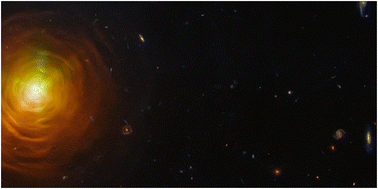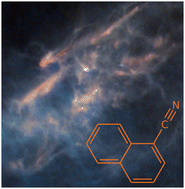Themed collection Astrochemistry at high resolution

List of participants
Faraday Discuss., 2023,245, 653-654
https://doi.org/10.1039/D3FD90044D
Poster list
Faraday Discuss., 2023,245, 651-652
https://doi.org/10.1039/D3FD90043F
Astrochemistry at high resolution: preface
Martin McCoustra, Chair of the Scientific Organising Committee, introduces the Faraday Discussion volume on Astrochemistry at high resolution.

Faraday Discuss., 2023,245, 9-10
https://doi.org/10.1039/D3FD90035E
Chemical conditions on Hycean worlds
We investigate possible chemical conditions on a canonical Hycean world, focusing on the present and primordial molecular composition of the atmosphere, and the inventory of bioessential elements for the origin and sustenance of life in the ocean.

Faraday Discuss., 2023,245, 80-111
https://doi.org/10.1039/D3FD00075C
The chemical inventory of the inner regions of planet-forming disks – the JWST/MINDS program
The Mid-InfraRed Instrument/Medium-Resolution Spectrometer (MIRI/MRS) on board the James Webb Space Telescope reveals the rich and diverse chemistry in the planet forming regions around Sun-like and low-mass stars.

Faraday Discuss., 2023,245, 112-137
https://doi.org/10.1039/D3FD00013C
Concluding remarks: Faraday Discussion on astrochemistry at high resolution
This paper presents a brief history of astrochemistry, summarises recent research presented at this Faraday Discussion and offers some thoughts on the future development of the subject.

Faraday Discuss., 2023,245, 638-650
https://doi.org/10.1039/D3FD00131H
Tracing the chemical footprint of shocks in AGN-host and starburst galaxies with ALMA multi-line molecular studies
We present an astrochemical modeling study with the aim of comparing shock chemistry traced by HNCO and SiO in two distinctively different environments: the AGN dominated region in the CND of NGC 1068 and the starburst-dominated region in the CMZ of NGC 253.

Faraday Discuss., 2023,245, 181-198
https://doi.org/10.1039/D3FD00007A
A statistical and machine learning approach to the study of astrochemistry
We use Bayesian inference together with the MOPED compression algorithm to help determine which species should be prioritised for future detections in order to better constrain the values of binding energies in the ISM.

Faraday Discuss., 2023,245, 569-585
https://doi.org/10.1039/D3FD00008G
Direct frequency comb spectroscopy of HCN to evaluate line lists
Direct frequency comb spectroscopy of HCN is performed using a high resolution, cross-dispersed spectrometer. Short-wave and mid-wave infrared instrumentation for precision molecular spectroscopy to test line lists is discussed.

Faraday Discuss., 2023,245, 368-379
https://doi.org/10.1039/D3FD00019B
Spiers Memorial Lecture: Astrochemistry at high resolution
This Spiers Memorial Lecture introduces the Faraday Discussion on ‘Astrochemistry at high resolution’, focusing on the special case of interstellar complex organic molecules (iCOMs).

Faraday Discuss., 2023,245, 11-51
https://doi.org/10.1039/D3FD00106G
The diverse chemistry of protoplanetary disks as revealed by JWST
Early results from JWST-MIRI programs on low- and high-mass protostars and disks show significant diversity in their mid-infrared spectra, most notably for CO2, H2O and C2H2. Benzene is detected in disks around very low mass stars.

Faraday Discuss., 2023,245, 52-79
https://doi.org/10.1039/D3FD00010A
An experimental and theoretical investigation of the N(2D) + C6H6 (benzene) reaction with implications for the photochemical models of Titan
Low temperature kinetics, crossed beam experiments, calculations of the underlying potential energy surface and of the product branching fractions for the N(2D) + benzene reaction are reported. The results have been used in a photochemical model of Titan.

Faraday Discuss., 2023,245, 327-351
https://doi.org/10.1039/D3FD00057E
Disentangling physics and chemistry in AGB outflows: revealing degeneracies when adding complexity
The first AGB chemical kinetics model that includes porosity, dust–gas chemistry and companion UV photons, allows us to unravel the interplay of the complexities and identify suites of molecules to determine the presence of a companion star.

Faraday Discuss., 2023,245, 586-608
https://doi.org/10.1039/D3FD00039G
High-resolution rovibrational and rotational spectroscopy of the singly deuterated cyclopropenyl cation, c-C3H2D+
The first rovibrational (IR) and rotational (mm-wave) spectra are measured for c-C3H2D+, a potential detection target in interstellar space.

Faraday Discuss., 2023,245, 298-308
https://doi.org/10.1039/D3FD00068K
Experimental, theoretical, and astrochemical modelling investigation of the gas-phase reaction between the amidogen radical (NH2) and acetaldehyde (CH3CHO) at low temperatures
The reaction of NH2 and CH3CHO becomes fast at low temperatures, and may be a potential source of CH3CO radicals in the interstellar medium.

Faraday Discuss., 2023,245, 261-283
https://doi.org/10.1039/D3FD00046J
Predicting observable infrared signatures of nanosilicates in the diffuse interstellar medium
Silicates are the main constituent of interstellar dust. Direct observations of nanometre-sized silicate grains would provide a smoking gun for the occurrence of grain condensation in the diffuse interstellar medium.

Faraday Discuss., 2023,245, 609-619
https://doi.org/10.1039/D3FD00055A
Streamers feeding the SVS13-A protobinary system: astrochemistry reveals accretion shocks?
We analyse deuterated water (HDO) and sulfur dioxide (SO2) at high-angular resolution in the binary system SVS13-A. We propose that molecular emission is produced by an accretion shock at the interface between the accretion streamer and the disk.

Faraday Discuss., 2023,245, 164-180
https://doi.org/10.1039/D3FD00018D
Infrared photodesorption of CO from astrophysically relevant ices studied with a free-electron laser
Resonant excitation of CO and water-containing ices with a free-electron laser leads to CO photodesorption.

Faraday Discuss., 2023,245, 446-466
https://doi.org/10.1039/D3FD00024A
Fingerprinting fragments of fragile interstellar molecules: dissociation chemistry of pyridine and benzonitrile revealed by infrared spectroscopy and theory
Fragmentation pathways of benzonitrile and pyridine are elucidated using cryogenic infrared ion spectroscopy, quantum-chemical calculations and molecular dynamics simulations.

Faraday Discuss., 2023,245, 221-244
https://doi.org/10.1039/D3FD00015J
A systematic mechanistic survey on the reactions between OH radical and CH3OH on ice
Our systematic computational study suggests that the nature of the binding site or the reaction site has a significant effect on the computed binding energies or reaction barriers.

Faraday Discuss., 2023,245, 508-518
https://doi.org/10.1039/D3FD00033H
Kinetics of CN (v = 1) reactions with butadiene isomers at low temperature by cw-cavity ring-down in a pulsed Laval flow with theoretical modelling of rates and entrance channel branching
Continuous-wave-cavity ring-down spectroscopy (CRDS) coupled with a pulsed uniform supersonic flow (Laval flow) are used to measure the reaction kinetics of the reaction of CN (v = 1) with 1,3- and 1,2-butadiene isomers at low temperature.

Faraday Discuss., 2023,245, 245-260
https://doi.org/10.1039/D3FD00029J
Hunting for interstellar molecules: rotational spectra of reactive species
Flash vacuum pyrolysis or DC discharge are exploited for the production of unstable/reactive species. A strategy relying on the interplay of experiment and theory is presented, which ultimately leads to line catalogs for astronomical searches.

Faraday Discuss., 2023,245, 309-326
https://doi.org/10.1039/D3FD00052D
Thermal behavior of astrophysical amorphous molecular ices
Cometary ice analogs: amorphous H2O ice can trap other molecules up to ∼30% by number, which are outgassed during ice crystallization (130 K to 150 K). Beyond 160 K, crystalline ice sublimes with only a minor fraction (<1%) of other molecules with it.

Faraday Discuss., 2023,245, 467-487
https://doi.org/10.1039/D3FD00048F
Preferential destruction of NH2-bearing complex interstellar molecules via gas-phase proton-transfer reactions
Destruction of large, interstellar organic molecules with high proton affinities is amplified due to proton transfer from NH4+. Chemical kinetic models indicate a strong destructive effect on NH2-bearing species, including methylamine and glycine.

Faraday Discuss., 2023,245, 541-568
https://doi.org/10.1039/D3FD00014A
Vacuum UV photodesorption of organics in the interstellar medium: an experimental study of formic acid HCOOH and methyl formate HCOOCH3-containing ices
The UV photodesorption of neutrals from ices comprising HCOOH and HCOOCH3 is studied. Photodesorption yields are provided from a variety of different desorbing species, highlighting the preponderant role played by photodissociation of the organics.

Faraday Discuss., 2023,245, 488-507
https://doi.org/10.1039/D3FD00004D
Searches for bridged bicyclic molecules in space—norbornadiene and its cyano derivatives
Laboratory rotational spectra of norbornadiene and its cyano derivatives were recorded using chirped-pulse millimetre-wave spectroscopy. These molecules were then searched for in the starless core TMC-1 using the QUIJOTE line survey.

Faraday Discuss., 2023,245, 284-297
https://doi.org/10.1039/D3FD00016H
New interstellar laboratories in the molecular ring
The so-called molecular ring has been mostly absent from astrochemical observations despite containing the bulk of the Milky Way’s molecular matter. A pilot survey of 11 molecular-ring giant molecular clouds with ALMA reveals new chemical stockrooms.

Faraday Discuss., 2023,245, 138-163
https://doi.org/10.1039/D3FD00003F
Experimental radiative cooling rates of a polycyclic aromatic hydrocarbon cation
The radiative cooling rate of cationic 1-cyanonaphthalene is determined from storage ring experiments and shown to be consistent with recurrent fluorescence. The rapid cooling helps explain the abundance of the neutral molecule in molecular clouds.

Faraday Discuss., 2023,245, 352-367
https://doi.org/10.1039/D3FD00005B
Size distribution of polycyclic aromatic hydrocarbons in space: an old new light on the 11.2/3.3 μm intensity ratio
Calculated infrared absorption intensities of PAHs that underlie the interpretation of infrared emission from the ISM are validated with experiments. An adjusted emission model implies that typical PAH sizes are smaller than previously estimated.

Faraday Discuss., 2023,245, 380-390
https://doi.org/10.1039/D2FD00180B
Laboratory astrochemistry of the gas phase: general discussion
Faraday Discuss., 2023,245, 391-445
https://doi.org/10.1039/D3FD90025H
Observational astrochemistry in the age of ALMA, NOEMA, JWST and beyond!: general discussion
Faraday Discuss., 2023,245, 199-220
https://doi.org/10.1039/D3FD90024J
Computational astrochemistry: general discussion
Faraday Discuss., 2023,245, 620-637
https://doi.org/10.1039/D3FD90027D
Laboratory astrochemistry of and on dust and ices: general discussion
Faraday Discuss., 2023,245, 519-540
https://doi.org/10.1039/D3FD90026F
About this collection
We are delighted to share with you a selection of the papers associated with a Faraday Discussion on Astrochemistry at high resolution. More information about the related event may be found here: http://rsc.li/astrochem-fd2023. Additional articles will be added to the collection as they are published. The final versions of all the articles presented and a record of the discussions will be published after the event.
The aim of this meeting is to bring together researchers from astronomy, gas-phase, solid state and surface physics, and chemistry communities to address the wide-ranging roles of chemistry in astronomy in the light of the wealth of observational detail becoming available in this era of high resolution astrochemistry. Our window on the universe is being opened more widely as new observational platforms are developed that will overcome the limitations of resources currently available to astronomers.
Together we will address the role of chemical spectroscopy in identifying chemical species and probing their environments; we will attempt to understand the interplay of gas-phase, surface, solid state and photochemically-induced processes that drive the chemical evolution of our Galaxy and others; how this chemical evolution is intimately involved in controlling the process of star and planet formation; and how chemistry brings us to the edge of biology. This meeting will cover 4 main themes: Observational astrochemistry in the age of ALMA, NOEMA, JWST and beyond, Laboratory astrochemistry of the gas phase, Laboratory astrochemistry of and on dust and ices and Computational astrochemistry.
On behalf of the Scientific Committee, we hope you join us and participate in this exciting event, and that you enjoy these articles and the record of the discussion.